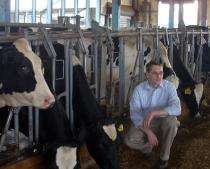Mice help researcher study how cow's diet affects milk-fat content

(PhysOrg.com) -- A dairy nutritionist in Penn State's College of Agricultural Sciences is conducting genetic research with mice to determine if cows can be influenced by diet to produce milk with a higher fat content.
You read that right.
"On the surface, it may seem like a strange concept, experimenting with mice to learn things about cows," said Kevin Harvatine, assistant professor of nutritional physiology. "But the lactating dairy cow is not amenable to transgenic approaches. The mouse offers the greatest opportunity for genomic manipulation, and we have successfully developed a lactating mouse model to investigate milk-fat depression in dairy cows."
"Ease of experimentation and genetic manipulation make the mouse valuable in investigating milk-fat synthesis, and our mouse model provides an exciting opportunity to conduct functional genomic experiments not feasible in large animals," he said.
Nutrition has a major impact on milk-fat yield in the dairy cow, Harvatine explained, and certain diets can cause milk-fat depression. The long-term goal of his research project, which is funded by a $350,000 grant from the Agriculture and Food Research Initiative of the U.S. Department of Agriculture's National Institute of Food and Agriculture, is to increase the efficiency of milk-fat synthesis by improving the understanding of the biological mechanisms underlying lactation and metabolism.
"The end goal is to understand the regulatory factors that determine the rate of milk-fat synthesis," he said. "On the dairy farm today, producers are really paid for pounds of protein and pounds of fat, so we want the cows to generate the most milk-fat possible."
The widely held misconception that farmers want cows to produce low-fat milk couldn't be farther from the truth, according to Harvatine, who works in collaboration with animal scientist Dale Bauman at Cornell University. The low-fat milk that most of the public wants to consume starts out as high-fat milk. The fat is skimmed off or removed in the creamery and is used to make very popular, higher-fat dairy products, such as ice cream.
"Milk is an important source of nutrients in American diets, with dairy products representing more than 10 percent of farm cash receipts in this country," he said. "Fat is its major energy component, accounting for many of the manufacturing characteristics of dairy products, including taste. But fat is also the most variable of milk's components."
"Our research has established that much of this variability is due to inhibition of milk-fat synthesis by unique bioactive fatty acids produced by metabolism of polyunsaturated fatty acids in the cow's rumen," he said. "Understanding the biology of milk-fat depression has exciting implications."
Harvatine hopes his research, portions of which have been published in the International Journal of Animal Biosciences, will lead to dairy-producer applications involving progressive management strategies in the production of milk fat. A clear understanding of the risk factors associated with low milk-fat production will help producers to steer clear of lost potential.
"In addition, understanding the important regulatory factors will provide insight into future methods to increase milk-fat synthesis," he said.
Provided by Pennsylvania State University
















